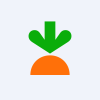Instacart demonstrates strong business quality with a dominant market position, innovative solutions, and solid financial performance. However, it faces challenges regarding average order value and advertising growth amidst a mixed macroeconomic landscape. Future prospects appear promising due to user engagement and innovation, though advertising growth may be constrained by external factors.
Analysis Date: February 25, 2025
Last Updated: March 11, 2025
Trailing Twelve Months (TTM) values provide a view of the company's performance over the last year.
Graham Value Metrics
Benjamin Graham's value investing approach focuses on finding stocks with a significant margin of safety between their intrinsic value and market price.
Intrinsic Value
Estimated fair value based on Graham's formula
$22.06
Current Market Price: $38.20
IV/P Ratio: 0.58x (>1.0 indicates undervalued)
Margin of Safety
Gap between intrinsic value and market price
-73.0%
Graham recommended a minimum of 20-30% margin of safety
Higher values indicate a greater potential discount to fair value
ROE: 14.61698384775308
ROA: 3.5965978128797085
Gross Profit Margin: 75.1036116044997
Net Profit Margin: 13.528715216104203
Trailing Twelve Months (TTM) values provide a view of the company's performance over the last year.
Strong Gross Profit Margin
75.11
Gross Profit Margin
CART's gross profit margin of 75.11% indicates high efficiency in production and pricing power, which is a strong indicator of profitability.
Good Net Profit Margin
The net profit margin of 13.46% demonstrates that CART is effective at converting revenue into actual profit, highlighting strong financial management.
Low Operating Profit Margin
12.16
Operating Profit Margin
With an operating profit margin of 12.16%, CART may face challenges controlling operational costs, which could impact long-term profitability.
About Profitability Metrics
Profitability metrics measure a company's ability to generate earnings relative to its revenue, operating costs, and other relevant metrics. Higher values generally indicate better performance.
Return on Equity (ROE)
Measures how efficiently a company uses its equity to generate profits
14.62%
10%
15%
Higher values indicate better returns for shareholders
TTM (as of 2025-04-16)
Return on Assets (ROA)
Measures how efficiently a company uses its assets to generate profits
3.60%
3%
7%
Higher values indicate better asset utilization
TTM (as of 2025-04-16)
Gross Profit Margin
Percentage of revenue retained after accounting for cost of goods sold
75.10%
20%
40%
Higher values indicate better efficiency in production
TTM (as of 2025-04-16)
Net Profit Margin
Percentage of revenue retained after accounting for all expenses
13.53%
8%
15%
Higher values indicate better overall profitability
TTM (as of 2025-04-16)
Excellent Liquidity Ratios
CART has a current ratio of 3.06 and a quick ratio of 3.06, indicating strong liquidity and ability to cover short-term obligations.
Minimal Debt Levels
CART's debt to equity ratio is a mere 0.0097, showcasing its low leverage and solid financial stability.
Zero Interest Coverage
An interest coverage ratio of 0.0 indicates that CART does not currently generate enough earnings to cover interest expenses, which is a significant concern.
About Financial Health Metrics
Financial health metrics assess a company's ability to meet its financial obligations and its overall financial stability.
Debt to Equity Ratio
Total debt divided by total equity
0.01x
1.0x
2.0x
Lower values indicate less financial leverage and risk
Less than 1.0 is conservative, 1.0-2.0 is moderate, >2.0 indicates high risk
Q4 2024
Current Ratio
Current assets divided by current liabilities
3.38x
1.0x
2.0x
Higher values indicate better short-term liquidity
Less than 1.0 is concerning, 1.0-2.0 is adequate, greater than 2.0 is good
Q4 2024


